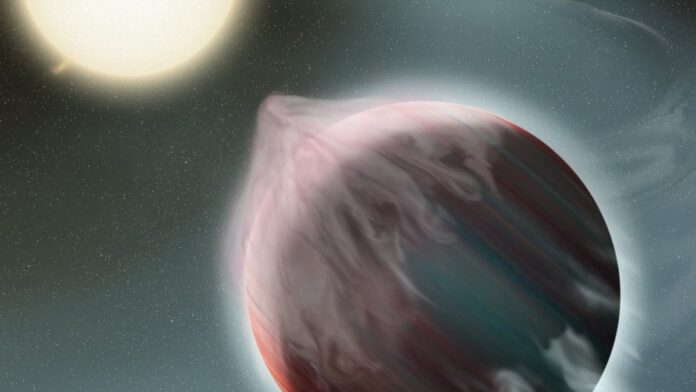A newly discovered distant mini-Neptune planet may possess its own atmosphere, ocean, or a combination of the two, even if they don’t last for long. The extrasolar planet, or exoplanet, designated HD-2047496 b located around 77 light-years from Earth revealed its characteristics to astronomers as it crossed the face of its parent star.
The discovery could help scientists better understand how planetary systems evolve and why there is an absence of Neptune-sized worlds close to their parent stars in the Milky Way.
The team of planetary scientists from around the globe was able to characterize the features of the exoplanet while analyzing data from its star collected by the High Accuracy Radial velocity Planet Searcher (HARPS). They combined this with data from the Transiting Exoplanet Survey Satellite (TESS) which revealed the brightness and wavelengths of light from the star, HD-207496 revealing the characteristics of the exoplanet as it crossed, or transited, its face.
Related: Exoplanets: Worlds Beyond Our Solar System
The astronomers were able to determine HD-2047496-b, which has the alternative name TOI-1099 b, has a width 2.25 times that of Earth, while its mass is around 6.1 times that of our planet. This means the exoplanet is less dense than Earth leading to the team categorizing it as a “mini-Neptune” — a planet less massive than Neptune but still resembling the solar system ice giant.
The team was also able to calculate that HD-2047496-b orbits its star in around just 6.4 Earth days at a distance of just 5.8 million miles (9.4 million kilometers). But, not everything about this newly discovered world is so certain.
HD-2047496-b likely has a rocky core covered by mostly water or gas, but the team doesn’t currently know which, or if it indeed has both. Models of the planet brought them no closer to determining the specifics of the exoplanet, but instead also pointed to the fact it may be water-rich, gas-rich, or both. But whatever the nature of the material that covers HD-2047496-b’s rocky core, the situation is likely to be temporary.
Even though its host star HD-2047496 is only around 80% the mass of the sun and 79% the width of our star, it is still large enough for its gravity to strip the exoplanet of its hydrogen and helium atmosphere, the team’s model suggested.
Most Neptune-like planets orbiting stars at such close distances would have had their atmospheres stripped and their oceans boiled away, with this being one of the suggested explanations for the fact that Neptune-like worlds are rarely found close to their stars, a problem called the “hot-Neptunian desert.” The Neptune-sized or sub-Neptune-sized planets are thus reduced in size to rocky cores corresponding with so-called super-Earth exoplanets.
Read more: Why are there so few ‘hot Neptune’ exoplanets?
HD-2047496-b might have escaped this fate because its star is around just 520 million years old, meaning the system it inhabits is relatively young, especially compared to our 4.6 billion-year-old solar system. Therefore, the star might not have had time to fully strip the planet’s atmosphere yet.
The astronomers calculate that if the planet’s atmosphere hasn’t already been stripped leaving it with just an ocean covering, then it should be ripped away within the next 500 million years. This will leave HD-2047496-b either as a rocky core covered by oceans, or a completely barren naked planetary core if it currently doesn’t have a mix of ocean and atmosphere.
The team favors an explanation for the planet that sees it covered by a mix of atmosphere and ocean rather than just an ocean or just an atmosphere, but added that further investigation of this world is necessary to determine its composition.
“Further observations of its possible atmosphere and/or mass-loss rate would allow us to distinguish between these two hypotheses,” the authors write (opens in new tab). “Such observations would determine if the planet remains above the radius gap or if it will shrink and be below the gap.”
The team’s research has been accepted for publication in the journal Astronomy & Astrophysics and is available on the paper repository arXiv. (opens in new tab)
Follow us on Twitter @Spacedotcom (opens in new tab) or on Facebook (opens in new tab).

